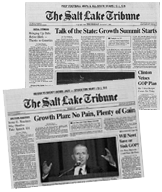Winter 1996
Utah Growth Summit Attracts Half-Million Citizens
By Ed Fouhy
Pew Center’s
Executive Director
An estimated half a million Utah citizens – about a fourth of the state’s population – took part in the biggest civic journalism initiative so far, the Utah Growth Summit, Dec. 6-8. It focused on three perennial issues in the fast-growing states of the West – transportation, land and water use.
All of the state’s commercial and public television stations broadcast a “roadblock” one-hour town meeting on the night of Dec. 6. The conversation continued on public television and radio stations the following night for 90 minutes. The broadcasts followed extensive coverage of the growth issues in the days preceding the summit, in the state’s daily newspapers, on radio talk shows and in both special and regularly scheduled television news programs. The process continued Dec. 8, with two hours of discussion on many of the state’s radio stations and an Internet chat with Gov. Mike Leavitt that drew so many people the computer system crashed.
Utah’s unprecedented effort to come to grips with growth problems began in July when Leavitt and legislative leaders announced their plan to engage citizens in the three areas “to create an environment that leads to legislative solutions.”
Three separate working groups, charged with writing plans to deal with growth, were appointed – a Republican group, a Democratic group and one of local government officials. Three days of hearings were held in November so citizens could provide input. Additional public comments were solicited through the mail and on a World Wide Web site.
 Proposals from the working groups were drafted then made public in late November and published as special inserts in Sunday newspapers Dec. 3, two days before the summit. The Salt Lake Tribune and Deseret News, the morning and afternoon newspapers published in the state capital, as well as smaller dailies around the state, carried extensive coverage and analysis of the competing plans.
Proposals from the working groups were drafted then made public in late November and published as special inserts in Sunday newspapers Dec. 3, two days before the summit. The Salt Lake Tribune and Deseret News, the morning and afternoon newspapers published in the state capital, as well as smaller dailies around the state, carried extensive coverage and analysis of the competing plans.
For the fiercely competitive Salt Lake television stations, seen all over the state through cable, agreement to suspend normal network programming for a prime-time hour was a tough sell. Janice Evans, assistant news director of CBS affiliate KUTV said, “If you’re in television today, you know that local is where it’s at. We didn’t want to cross the line but we wanted to be community-minded. . . We saw this, and I guess the other stations did too, as an opportunity to serve the community.”
KUTV not only carried the “roadblock” program, it did three half-hour news specials, including its own town meeting, the night before the official version. “The summit agenda gave a focus to stories on growth we had been wanting to do,” Evans said.
The broadcasters solved their competitive problem by agreeing that each station’s news department would contribute one short documentary segment to the program to frame the issues. To avoid disputes over which station’s anchor team would host the program series, they approached the Pew Center. I was pleased to be the moderator.
About 600 Utahans attended the town meeting in person on the first night, another 300 were at the second night’s meeting while news stories generated by the summit dominated the front pages of the dailies for the entire summit week.
Radio talk programs centered on the summit issues for much of the week as well, although one Salt Lake City talk jock used it as a target, calling the summit, “Just a big waste of electricity.”
Leavitt, state senate president Lane Beattie and other officials who appeared on the TV town meeting were pleased by the turnout. “I think we finally found a way to get people’s attention,” said Leavitt.